The Intellectual Evolution of Educational Leadership Research: A Combined Bibliometric and Thematic Analysis Using SciMAT
Abstract
1. Introduction
- What is the volume and growth trajectory of the ELR field?
- What is the nature of the ELR field in terms of “performance results”; that is, citation impacts, most influential authors, journals, and publications as well as their geographical distribution?
- How do prominent, emerging, and declining themes change over time?
- How have the conceptual and thematic strands evolved over time?
2. Materials and Methods
2.1. Data Search and Extraction
- Only journal articles were included because keywords were significant for the analysis. Many books and book chapters do not provide explicit keywords. We also excluded conference proceedings as we targeted rigorously peer-reviewed research.
- The articles included were all in English as it has become the language of science globally and the keywords used needed to be in the same language to produce meaningful results.
- Articles addressing K-12 schools were included while those addressing higher education were excluded due to diverse points of interest in these two fields.
2.2. Analysis and Interpretation of Maps
3. Results and Discussion
3.1. Bibliometric Performance Analysis
3.2. Science Mapping Analysis
3.2.1. Period 1 (1907–2004)
3.2.2. Period 2 (2005–2012)
3.2.3. Period 3 (2013–2019)
3.2.4. Period 4 (2020–2023)
3.3. Thematic Evolution Structure
4. Conclusions and Implications
Limitations of the Study
Authors cite other papers for all kinds of reasons: to refer to a particular methodology, to point out examples of other work done on the same topic, to reinforce a point they make in the text, to give credit to their mentors or experts in the field, or even to discuss examples of flawed methods or misleading results. Current bibliometric indicators cannot account for this variety; they count all citations equally, regardless of the actual reason for the citation (pp. 219–220).
Author Contributions
Funding
Institutional Review Board Statement
Informed Consent Statement
Data Availability Statement
Conflicts of Interest
References
- Andersen, J.A. An old man and the “sea of leadership”. J. Leadersh. Stud. 2016, 9, 70–81. [Google Scholar] [CrossRef]
- Heck, R.H.; Hallinger, P. The study of educational leadership and management: Where does the field stand today? Educ. Manag. Admin. Leadersh. 2005, 33, 229–244. [Google Scholar] [CrossRef]
- Murphy, J. Reculturing Educational Leadership: The ISLLC Standards Ten Years Out; the National Policy Board for Educational Administration: Arlington, The USA, 2003; Paper Prepared for the National Policy Board for Educational Administration. Available online: https://eric.ed.gov/?id=ED481619 (accessed on 8 August 2023).
- Gunter, H.; Ribbins, P. The field of educational leadership: Studying maps and mapping studies. Brit. J. Educ. Stud. 2003, 51, 254–281. [Google Scholar] [CrossRef]
- Hunt, J.G.; Dodge, G.E. Leadership déjà vu all over again. Leadersh. Q. 2000, 11, 435–458. [Google Scholar] [CrossRef]
- Stewart, J. Transformational leadership: An evolving concept examined through the works of Burns, Bass, Avolio, and Leithwood. Can. J. Educ. Admin. Policy 2006, 54, 1–60. Available online: https://cdm.ucalgary.ca/index.php/cjeap/article/view/42735 (accessed on 5 May 2023).
- Hallinger, P.; Kovačević, J. A bibliometric review of research on educational administration: Science mapping the literature, 1960 to 2018. Rev. Educ. Res. 2019, 89, 335–369. [Google Scholar] [CrossRef]
- Tian, M.; Huber, S.G. Mapping educational leadership, administration and management research 2007–2016: Thematic strands and the changing landscape. J. Educ. Admin. 2020, 58, 129–150. [Google Scholar] [CrossRef]
- Ahmed, E.I. Systematic review of research on educational leadership and management in Muslim societies. Educ. Manag. Admin. Leadersh. 2023, 51, 52–74. [Google Scholar] [CrossRef]
- Bellibaş, M.Ş.; Gümüş, S. A systematic review of educational leadership and management research in Turkey: Content analysis of topics, conceptual models, and methods. J. Educ. Admin. 2019, 57, 731–747. [Google Scholar] [CrossRef]
- Castillo, F.A.; Hallinger, P. Systematic review of research on educational leadership and management in Latin America, 1991–2017. Educ. Manag. Admin. Leadersh. 2018, 46, 207–225. [Google Scholar] [CrossRef]
- Hallinger, P. Science mapping the knowledge base on educational leadership and management from the emerging regions of Asia, Africa and Latin America, 1965–2018. Educ. Manag. Admin. Leadersh. 2020, 48, 209–230. [Google Scholar] [CrossRef]
- Hallinger, P.; Bryant, D.A. Review of research publications on educational leadership and management in Asia: A comparative analysis of three regions. Oxf. Rev. Educ. 2013, 39, 307–328. [Google Scholar] [CrossRef]
- Hammad, W.; Samier, E.A.; Mohammed, A. Mapping the field of educational leadership and management in the Arabian Gulf region: A systematic review of Arabic research literature. Educ. Manag. Admin. Leadersh. 2022, 50, 6–25. [Google Scholar] [CrossRef]
- Oplatka, I.; Arar, K. The research on educational leadership and management in the Arab world since the 1990s: A systematic review. Rev. Educ. 2017, 5, 267–307. [Google Scholar] [CrossRef]
- Daniëls, E.; Hondeghem, A.; Dochy, F. A review on leadership and leadership development in educational settings. Educ. Res. Rev. 2019, 27, 110–125. [Google Scholar] [CrossRef]
- Hitt, D.H.; Tucker, P.D. Systematic review of key leader practices found to influence student achievement: A unified framework. Rev. Educ. Res. 2016, 86, 531–569. [Google Scholar] [CrossRef]
- Özdemir, N.; Gümüş, S.; Kılınç, A.Ç.; Bellibaş, M.Ş. A systematic review of research on the relationship between school leadership and student achievement: An updated framework and future direction. Educ. Manag. Admin. Leadersh. 2022. early access. [Google Scholar] [CrossRef]
- Wu, H.; Shen, J. The association between principal leadership and student achievement: A multivariate meta-meta-analysis. Educ. Res. Rev. 2022, 35, 100423. [Google Scholar] [CrossRef]
- Doğan, E.; Sönmez, E. An analysis of instructional leadership studies in Türkiye: A meta–synthesis study. J. Educ. Stud. Multidiscip. Approaches 2023, 3, 1–28. [Google Scholar] [CrossRef]
- Gümüş, S.; Hallinger, P.; Cansoy, R.; Bellibaş, M.Ş. Instructional leadership in a centralized and competitive educational system: A qualitative meta-synthesis of research from Turkey. J. Educ. Admin. 2021, 59, 702–720. [Google Scholar] [CrossRef]
- Hallinger, P. Reviewing reviews of research in educational leadership: An empirical assessment. Educ. Admin. Q. 2014, 50, 539–576. [Google Scholar] [CrossRef]
- Wang, Y. The panorama of the last decade’s theoretical groundings of educational leadership research: A concept co-occurrence network analysis. Educ. Admin. Q. 2018, 54, 327–365. [Google Scholar] [CrossRef]
- Palmatier, R.W.; Houston, M.B.; Hulland, J. Review articles: Purpose, process, and structure. J. Acad. Mark. Sci. 2018, 46, 1–5. [Google Scholar] [CrossRef]
- Koseoglu, M.A.; Rahimi, R.; Okumus, F.; Liu, J. Bibliometric studies in tourism. Ann. Tour. Res. 2016, 61, 180–198. [Google Scholar] [CrossRef]
- Pereira, R.S.; Santos, I.C.; Oliveira, K.D.; Leao, N.C. Meta–analysis as a research tool: A systematic review of bibliometric studies in administration. RAM 2019, 20, eRAMG190186. [Google Scholar] [CrossRef]
- Radu, A.F.; Bungau, S.G.; Negru, P.A.; Marcu, M.F.; Andronie-Cioara, F.L. In-depth bibliometric analysis and current scientific mapping research in the context of rheumatoid arthritis pharmacotherapy. Biomed. Pharmacother. 2022, 154, 113614. [Google Scholar] [CrossRef]
- Pessin, V.Z.; Yamane, L.H.; Siman, R.R. Smart bibliometrics: An integrated method of science mapping and bibliometric analysis. Scientometrics 2022, 127, 3695–3718. [Google Scholar] [CrossRef]
- Gümüş, S.; Bellibaş, M.S.; Esen, M.; Gümüş, E. A systematic review of studies on leadership models in educational research from 1980 to 2014. Educ. Manag. Admin. Leadersh. 2018, 46, 25–48. [Google Scholar] [CrossRef]
- Hallinger, P.; Kovačević, J. Mapping the intellectual lineage of educational management, administration and leadership, 1972–2020. Educ. Manag. Admin. Leadersh. 2022, 50, 192–216. [Google Scholar] [CrossRef]
- Moral-Munoz, J.A.; Herrera-Viedma, E.; Santisteban-Espejo, A.; Cobo, M.J. Software tools for conducting bibliometric analysis in science: An up-to-date review. Prof. Inf. 2020, 29, 1699–2407. [Google Scholar] [CrossRef]
- Cobo, M.J.; López-Herrera, A.G.; Herrera-Viedma, E.; Herrera, F. An approach for detecting, quantifying, and visualizing the evolution of a research field: A practical application to the Fuzzy Sets Theory field. J. Informetr. 2011, 5, 146–166. [Google Scholar] [CrossRef]
- Cobo, M.J.; López-Herrera, A.G.; Herrera-Viedma, E.; Herrera, F. SciMAT: A new science mapping analysis software tool. J. Am. Soc. Inf. Sci. Tec. 2012, 63, 1609–1630. [Google Scholar] [CrossRef]
- Cooper, I.D. What is a “mapping study?”. J. Med. Libr. Assoc. 2016, 104, 76. [Google Scholar] [CrossRef] [PubMed]
- Chen, C. Science mapping: A systematic review of the literature. J. Data Inf. Sci. 2017, 2, 1–40. [Google Scholar] [CrossRef]
- Sott, M.K.; Furstenau, L.B.; Kipper, L.M.; Rodrigues, Y.P.R.; Lopez–Robles, J.R.; Giraldo, F.D.; Cobo, M.J. Process modeling for smart factories: Using science mapping to understand the strategic themes, main challenges and future trends. Bus. Process Manag. J. 2021, 27, 1391–1417. [Google Scholar] [CrossRef]
- Hallinger, P.; Kulophas, D. The evolving knowledge base on leadership and teacher professional learning: A bibliometric analysis of the literature, 1960–2018. Prof. Dev. Educ. 2019, 46, 521–540. [Google Scholar] [CrossRef]
- Moher, D.; Liberati, A.; Tetzlaff, J.; Altman, D.G.; PRISMA Group. Preferred reporting items for systematic reviews and meta-analyses: The PRISMA statement. Ann. Intern. Med. 2009, 151, 264–269. [Google Scholar] [CrossRef] [PubMed]
- Sánchez-Camacho, C.; Martín-Consuegra, D.; Carranza, R. An analysis of the scientific literature produced on bank marketing through bibliometrics and scientific mapping–what has been the role of sales in banking? Int. J. Bank Mark. 2020, 39, 927–954. [Google Scholar] [CrossRef]
- López-Robles, J.R.; Otegi-Olaso, J.R.; Gómez, I.P.; Cobo, M.J. 30 years of intelligence models in management and business: A bibliometric review. Int. J. Info. Manag. 2019, 48, 22–38. [Google Scholar] [CrossRef]
- Bush, T.; Abdul Hamid, S.; Ng, A.; Kaparou, M. School leadership theories and the Malaysia education blueprint: Findings from a systematic literature review. Int. J. Educ. Manag. 2018, 32, 1245–1265. [Google Scholar] [CrossRef]
- Harris, A. COVID-19-school leadership in crisis? J. Prof. Cap. Community 2020, 5, 321–326. [Google Scholar] [CrossRef]
- Fotheringham, P.; Harriott, T.; Healy, G.; Arenge, G.; Wilson, E. Pressures and influences on school leaders navigating policy development during the COVID-19 pandemic. Brit. Educ. Res. J. 2022, 48, 201–227. [Google Scholar] [CrossRef]
- Harris, A.; Jones, M. COVID-19-school leadership in disruptive times. Sch. Leadersh. Manag. 2020, 40, 243–247. [Google Scholar] [CrossRef]
- Sott, M.K.; Bender, M.S.; Furstenau, L.B.; Machado, L.M.; Cobo, M.J.; Bragazzi, N.L. 100 years of scientific evolution of work and organizational psychology: A bibliometric network analysis from 1919 to 2019. Front. Psychol. 2020, 11, 598676. [Google Scholar] [CrossRef]
- Riehl, C.J. Mostly unpunctuated disequilibrium: A commentary on new directions in research and practice in education leadership. In Challenges and Opportunities of Educational Leadership Research and Practice: The State of the Field and Its Multiple Futures; Bowers, A.J., Shoho, A.R., Barnett, B.G., Eds.; Information Age: New York, NY, USA, 2015; Volume 6, pp. 225–248. [Google Scholar]
- Robinson, V.M.; Lloyd, C.A.; Rowe, K.J. The impact of leadership on student outcomes: An analysis of the differential effects of leadership types. Educ. Admin. Q. 2008, 44, 635–674. [Google Scholar] [CrossRef]
- Leithwood, K.; Harris, A.; Hopkins, D. Seven strong claims about successful school leadership. Sch. Leadersh. Manag. 2008, 28, 27–42. [Google Scholar] [CrossRef]
- Bossert, S.; Dwyer, D.; Rowan, B.; Lee, G. The instructional management role of the principal. Educ. Admin. Q. 1982, 18, 34–64. [Google Scholar] [CrossRef]
- Hallinger, P.; Murphy, J. The social context of effective schools. Am. J. Educ. 1986, 94, 328–355. [Google Scholar] [CrossRef]
- Leithwood, K.; Montgomery, D. The role of the elementary principal in program improvement. Rev. Educ. Res. 1982, 52, 309–339. [Google Scholar] [CrossRef]
- Glasman, N.S.; Heck, R.H. The changing leadership role of the principal: Implications for principal assessment. Peabody J. Educ. 1992, 68, 5–24. [Google Scholar] [CrossRef]
- Hallinger, P. Leading educational change: Reflections on the practice of instructional and transformational leadership. Camb. J. Educ. 2003, 33, 329–352. [Google Scholar] [CrossRef]
- Glickman, C. Has Sam and Samantha’s time come at last? Educ. Leadersh. 1989, 46, 4–9. Available online: https://eric.ed.gov/?id=ej388734 (accessed on 21 August 2023).
- Hallinger, P.; Heck, R. Reassessing the principal’s role in school effectiveness: A review of empirical research, 1980–1985. Educ. Admin. Q. 1996, 32, 5–44. [Google Scholar] [CrossRef]
- Hallinger, P. Reshaping the Landscape of School Leadership Development: A Global Perspective; Taylor & Francis: Amsterdam, The Netherlands, 2003. [Google Scholar]
- Marks, H.M.; Printy, S.M. Principal leadership and school performance: An integration of transformational and instructional leadership. Educ. Admin. Q. 2003, 39, 370–397. [Google Scholar] [CrossRef]
- Murphy, J.; Hallinger, P.; Mitman, A. Problems with research on educational leadership: Issues to be addressed. Educ. Eval. Policy Anal. 1983, 5, 297–305. [Google Scholar] [CrossRef]
- Fullan, M. Leading in a Culture of Change, 1st ed.; Jossey-Bass: Hoboken, NJ, USA, 2001. [Google Scholar]
- Darling-Hammond, L.; Goodwin, A.L. Progress towards professionalism in teaching. In Challenges and Achievements of American Education: The 1993 ASCD Yearbook; Cawelti, G., Ed.; Association for Supervision and Curriculum Development: Alexandria, VI, USA, 1993; pp. 19–52. [Google Scholar]
- Smylie, M.A.; Denny, J.W. Teacher leadership: Tensions and ambiguities in organizational perspectives. Educ. Admin. Q. 1990, 26, 235–259. [Google Scholar] [CrossRef]
- Leithwood, K.; Jantzi, D. Principal and teacher leader effects: A replication. Sch. Leadersh. Manag. 2000, 20, 415–434. [Google Scholar] [CrossRef]
- Gibb, C.A. Leadership. In Handbook of Social Psychology; Lindzey, G., Ed.; Addison-Wesley: Boston, MA, USA, 1954; pp. 877–917. [Google Scholar]
- Gronn, P. Distributed properties: A new architecture for leadership. Educ. Manag. Admin. Leadersh. 2000, 28, 317–338. [Google Scholar] [CrossRef]
- Spillane, J.P.; Halverson, R.; Diamond, J.B. Investigating school leadership practice: A distributed perspective. Educ. Res. 2001, 30, 23–28. [Google Scholar] [CrossRef]
- Spillane, J.P.; Halverson, R.; Diamond, J.B. Towards a theory of leadership practice: A distributed perspective. J. Curric. Stud. 2004, 36, 3–34. [Google Scholar] [CrossRef]
- Murphy, J.; Hallinger, P. The superintendent as instructional leader: Findings from effective school districts. J. Educ. Admin. 1986, 24, 213–236. [Google Scholar] [CrossRef]
- LaRocque, L.; Coleman, P. Quality control: School accountability and district ethos. In Educational Policy for Effective Schools; Holmes, M., Leithwood, K., Musella, D., Eds.; OISE Press: Toronto, ON, Canada, 1990; pp. 168–191. [Google Scholar]
- Murphy, J.; Hallinger, P. Characteristics of instructionally effective districts. J. Educ. Res. 1988, 81, 175–181. [Google Scholar] [CrossRef]
- Busher, H.; Harris, A. Leading Subject Areas, Improving Schools; Paul Chapman: London, UK, 2000. [Google Scholar]
- Brown, M.; Rutherford, D.; Boyle, B. Leadership for school improvement: The role of the head of department in UK secondary schools. Sch. Eff. Sch. Improv. 2000, 11, 237–258. [Google Scholar] [CrossRef]
- Glover, D.; Miller, D. The working day of the subject leader and the impact of interruptions on teaching and learning in secondary schools. Res. Educ. 1999, 62, 55–65. [Google Scholar] [CrossRef]
- Hammersley-Fletcher, L. Becoming a subject leader: What’s in a name? subject leadership in English primary schools. Sch. Leadersh. Manag. 2002, 22, 407–420. [Google Scholar] [CrossRef]
- Bennett, N.W.; Newton, C.W.; Woods, P.A.; Economou, A. The Role and Purpose of Middle Leaders in Schools; Nottingham National College for School Leadership: London, UK, 2003. [Google Scholar]
- Eagly, A.H.; Johnson, B.T. Gender and leadership style: A meta-analysis. Psychol. Bullet. 1990, 108, 233–256. [Google Scholar] [CrossRef]
- Eagly, A.H.; Karau, S.J.; Johnson, B.T. Gender and leadership style among school principals: A meta-analysis. Educ. Admin. Q. 1992, 28, 76–102. [Google Scholar] [CrossRef]
- Bossert, S. School effects. In Handbook of Research on Educational Administration; Boyan, N., Ed.; Longman: London, UK, 1988; pp. 341–354. [Google Scholar]
- Heck, R.; Larsen, T.; Marcoulides, G. Principal leadership and school achievement: Validation of a causal model. Educ. Admin. Q. 1990, 26, 94–125. [Google Scholar] [CrossRef]
- Witziers, B.; Bosker, R.J.; Krüger, M.L. Educational leadership and student achievement: The elusive search for an association. Educ. Admin. Q. 2003, 39, 398–425. [Google Scholar] [CrossRef]
- Hallinger, P. Leadership for learning: Lessons from 40 years of empirical research. J. Educ. Admin. 2011, 49, 125–142. [Google Scholar] [CrossRef]
- Leithwood, K.; Jantzi, D. A review of transformational school leadership research 1996–2005. Leadersh. Policy Sch. 2005, 4, 177–199. [Google Scholar] [CrossRef]
- Theoharis, G. Social justice educational leaders and resistance: Toward a theory of social justice leadership. Educ. Admin. Q. 2007, 43, 221–258. [Google Scholar] [CrossRef]
- Gronn, P. The future of distributed leadership. J. Educ. Admin. 2008, 46, 141–158. [Google Scholar] [CrossRef]
- Hargreaves, A.; Fink, D. Distributed leadership: Democracy or delivery? J. Educ. Admin. 2008, 46, 229–240. [Google Scholar] [CrossRef]
- Harris, A. Distributed leadership: Conceptual confusion and empirical reticence. Int. J. Leadersh. Educ. 2007, 10, 315–325. [Google Scholar] [CrossRef]
- Harris, A. Distributed leadership: According to the evidence. J. Educ. Admin. 2008, 46, 172–188. [Google Scholar] [CrossRef]
- Spillane, J.P. Distributed leadership. Educ. Forum 2005, 69, 143–150. [Google Scholar] [CrossRef]
- Hulpia, H.; Devos, G.; Rosseel, Y. Development and validation of scores on the distributed leadership inventory. Educ. Psychol. Meas. 2009, 69, 1013–1034. [Google Scholar] [CrossRef]
- Nguni, S.; Sleegers, P.; Denessen, E. Transformational and transactional leadership effects on teachers’ job satisfaction, organizational commitment, and organizational citizenship behavior in primary schools: The Tanzanian case. Sch. Eff. Sch. Improv. 2006, 17, 145–177. [Google Scholar] [CrossRef]
- Tschannen-Moran, M. Fostering teacher professionalism in schools: The role of leadership orientation and trust. Educ. Admin. Q. 2009, 45, 217–247. [Google Scholar] [CrossRef]
- Wahlstrom, K.L.; Louis, K.S. How teachers experience principal leadership: The roles of professional community, trust, efficacy, and shared responsibility. Educ. Admin. Q. 2008, 44, 458–495. [Google Scholar] [CrossRef]
- Leithwood, K.; Patten, S.; Jantzi, D. Testing a conception of how school leadership influences student learning. Educ. Admin. Q. 2010, 46, 671–706. [Google Scholar] [CrossRef]
- Wenner, J.A.; Campbell, T. The theoretical and empirical basis of teacher leadership: A review of the literature. Rev. Educ. Res. 2017, 87, 134–171. [Google Scholar] [CrossRef]
- Sun, J. Conceptualizing the critical path linked by teacher commitment. J. Educ. Admin. 2015, 53, 597–624. [Google Scholar] [CrossRef]
- Crow, G.; Day, C.; Møller, J. Framing research on school principals’ identities. International J. Leadersh. Educ. 2017, 20, 265–277. [Google Scholar] [CrossRef]
- Curtis, R. Finding a New Way: Leveraging Teacher Leadership to Meet Unprecedented Demands; The Aspen Institute: Aspen, CO, USA, 2013. [Google Scholar]
- Neumerski, C.M. Rethinking instructional leadership, a review: What do we know about principal, teacher, and coach instructional leadership, and where should we go from here? Educ. Admin. Q. 2012, 49, 310–347. [Google Scholar] [CrossRef]
- Ingersoll, R.; Perda, D. How high is teacher turnover and is it a problem? J. Res. Sci. Teach. 2012. Available online: http://onlinelibrary.wiley.com/journal/10.1002/(ISSN)10982736/homepage/ForAuthors.html (accessed on 28 July 2023).
- Northouse, P.G. Leadership: Theory and Practice, 7th ed.; Sage Publications: Newbury Park, CA, USA, 2016. [Google Scholar]
- Grissom, J.A.; Egalite, A.J.; Lindsay, C.A. How Principals Affect Students and Schools: A Systematic Synthesis of Two Decades of Research; Wallace Foundation: New York, NY, USA, 2021. [Google Scholar]
- Ng, D.; Nguyen, D.T.; Wong, B.K.S.; Choy, W.K.W. A review of Singapore principals’ leadership qualities, styles, and roles. J Educ. Admin. 2015, 53, 512–533. [Google Scholar] [CrossRef]
- Meyers, C.V.; Hitt, H.D. School turnaround principals: What does initial research literature suggest they are doing to be successful? J. Educ. Stud. Placed Risk. 2017, 22, 38–56. [Google Scholar] [CrossRef]
- Grissom, J.A.; Loeb, S. Triangulating principal effectiveness: How perspectives of parents, teachers, and assistant principals identify the central importance of managerial skills. Am. Educ. Res. J. 2011, 48, 1091–1123. [Google Scholar] [CrossRef]
- Grissom, J.A.; Loeb, S.; Mitani, H. Principal time management skills: Explaining patterns in principals’ time use, job stress, and perceived effectiveness. J. Educ. Adm. 2015, 53, 773–793. [Google Scholar] [CrossRef]
- Horng, E.; Loeb, S. New thinking about instructional leadership. Phi Delta Kappan 2010, 92, 66–69. [Google Scholar] [CrossRef]
- Bush, T.; Glover, D. School leadership models: What do we know? Sch. Leadersh. Manag. 2014, 34, 553–571. [Google Scholar] [CrossRef]
- Moller, J. The construction of a public face as a school principal. Int. J. Educ. Manag. 2012, 26, 452–460. [Google Scholar] [CrossRef]
- Scribner, S.P.; Crow, G.M. Employing professional identities: Case study of a high school principal in a reform setting. Leadersh. Policy Sch. 2012, 11, 243–274. [Google Scholar] [CrossRef]
- Wenger, E. Communities of Practice. Learning, Meaning, and Identity; Cambridge University Press: Cambridge, MA, USA, 1998. [Google Scholar]
- Burke, P.J.; Stets, J.E. Identity Theory; Oxford University Press: London, UK, 2009. [Google Scholar]
- Ibara, E.C. Professional development of principals: A path to effective secondary school administration in Nigeria. Afr. Educ. Rev. 2014, 11, 674–689. [Google Scholar] [CrossRef]
- Jacob, R.; Goddard, R.; Kim, M.; Miller, R.; Goddard, Y. Exploring the causal impact of the McREL Balanced Leadership Program on leadership, principal efficacy, instructional climate, educator turnover, and student achievement. Educ. Eval. Policy Anal. 2015, 37, 314–332. [Google Scholar] [CrossRef]
- Tingle, E.; Corrales, A.; Peters, M.L. Leadership development programs: Investing in school principals. Educ. Stud. 2019, 45, 1–16. [Google Scholar] [CrossRef]
- Levine, A. Educating School Leaders; The Annenberg Foundation, Ford Foundation, Ewing Marion Kauffman Foundation & the Wallace Foundation: New York, NY, USA, 2005. [Google Scholar]
- Darling-Hammond, L.; Meyerson, D.; LaPointe, M.; Orr, M.T. Preparing Principals for A Changing World: Lessons from Effective School Leadership Programs; John Wiley & Sons: Hoboken, NJ, USA, 2009. [Google Scholar]
- Davis, S.H.; Darling-Hammond, L. Innovative principal preparation programs: What works and how we know. Plan. Chang. 2012, 43, 25–45. Available online: https://eric.ed.gov/?id=EJ977545 (accessed on 12 August 2023).
- Murphy, J. The Landscape of Leadership Preparation: Reframing the Education of School Administrators; Corwin Press: Thousand Oaks, CA, USA, 1992. [Google Scholar]
- Mestry, R. Empowering principals to lead and manage public schools effectively in the 21st century. S. Afr. J. Educ. 2017, 37, 1–11. Available online: https://hdl.handle.net/10520/EJC-5cda88587 (accessed on 8 August 2023). [CrossRef]
- Naidoo, P. Perceptions of teachers and school management teams of the leadership roles of public-school principals. S. Afr. J. Educ. 2019, 39, 1–15. [Google Scholar] [CrossRef]
- Nir, A.E.; Hameiri, L. School principals’ leadership style and school outcomes: The mediating effect of powerbase utilization. J. Educ. Admin. 2014, 52, 210–227. [Google Scholar] [CrossRef]
- Urick, A.; Bowers, A.J. What are the different types of principals across the United States? A latent class analysis of principal perception of leadership. Educ. Admin. Q. 2014, 50, 96–134. [Google Scholar] [CrossRef]
- Wang, L.H.; Gurr, D.; Drysdale, L. Successful school leadership: Case studies of four Singapore primary schools. J. Educ. Admin. 2016, 54, 1–22. [Google Scholar] [CrossRef]
- Diamond, J.B.; Spillane, J.P. School leadership and management from a distributed perspective: A 2016 retrospective and prospective. Manag. Educ. 2016, 30, 147–154. [Google Scholar] [CrossRef]
- Day, C.; Gu, Q.; Sammons, P. The impact of leadership on student outcomes: How successful school leaders use transformational and instructional strategies to make a difference. Educ. Admin. Q. 2016, 52, 221–258. [Google Scholar] [CrossRef]
- Hou, Y.; Cui, Y.; Zhang, D. Impact of instructional leadership on high school student academic achievement in China. Asia Pac. Educ. Rev. 2019, 20, 543–558. [Google Scholar] [CrossRef]
- Rodrigues, H.P.C.; de Lima, J.A. Instructional leadership and student achievement: School leaders’ perspectives. Int. J. Leadersh. Educ. early access. 2021. [Google Scholar] [CrossRef]
- Qadach, M.; Schechter, C.; Da’as, R. Instructional leadership and teachers’ intent to leave: The mediating role of collective teacher efficacy and shared vision. Educ. Manag. Admin. Leadersh. 2020, 48, 617–634. [Google Scholar] [CrossRef]
- Leithwood, K.; Harris, A.; Hopkins, D. Seven strong claims about successful school leadership revisited. Sch. Leadersh. Manag. 2020, 40, 5–22. [Google Scholar] [CrossRef]
- Heck, R.H.; Hallinger, P. Modeling the longitudinal effects of school leadership on teaching and learning. J. Educ. Adm. 2014, 52, 653–681. [Google Scholar] [CrossRef]
- Goddard, R.D.; Bailes, L.P.; Kim, M. Principal efficacy beliefs for instructional leadership and their relation to teachers’ sense of collective efficacy and student achievement. Leadersh. Policy Sch. 2021, 20, 472–493. [Google Scholar] [CrossRef]
- Liu, Y.; Bellibas, M.S.; Gümüş, S. The effect of instructional leadership and distributed leadership on teacher self–efficacy and job satisfaction: Mediating roles of supportive school culture and teacher collaboration. Educ. Manag. Admin. Leadersh. 2021, 49, 430–453. [Google Scholar] [CrossRef]
- Kemethofer, D.; Helm, C.; Warwas, J. Does educational leadership enhance instructional quality and student achievement? The case of Austrian primary school leaders. Int. J. Leadersh. Educ. 2022. early access. [Google Scholar] [CrossRef]
- Shaked, H. Instructional leadership during the COVID-19 pandemic: The case of Israel. Educ. Manag. Admin. Leadersh. 2022. early access. [Google Scholar] [CrossRef]
- Longmuir, F. Leading in lockdown: Community, communication and compassion in response to the COVID-19 crisis. Educ. Manag. Admin. Leadersh. 2021. early access. [Google Scholar] [CrossRef]
- Forfang, H.; Paulsen, J.M. Linking school leaders’ core practices to organizational school climate and student achievements in Norwegian high-performing and low–performing rural schools. Educ. Manag. Admin. Leadersh. 2021. early access. [Google Scholar] [CrossRef]
- Weiner, J.; Francois, C.; Stone-Johnson, C.; Childs, J. Keep safe, keep learning: Principals’ role in creating psychological safety and organizational learning during the COVID-19 pandemic. Front. Educ. 2021, 5, 618483. [Google Scholar] [CrossRef]
- Lopez, A.E.; Hossain, F. Exploring possibilities and challenges of instructional leadership in challenging times. J. Sch. Leadersh. 2021, 31, 271–273. [Google Scholar] [CrossRef]
- Karakose, T.; Tülübaş, T.; Papadakis, S. The scientific evolution of social justice leadership in education: Structural and longitudinal analysis of the existing knowledge Base, 2003–2022. Front. Educ. 2023, 8, 1139648. [Google Scholar] [CrossRef]
- Gümüş, S.; Bellibaş, M.Ş.; Pietsch, M. School leadership and achievement gaps based on socioeconomic status: A search for socially just instructional leadership. J. Educ. Admin. 2022, 60, 419–438. [Google Scholar] [CrossRef]
- Karakose, T.; Kardas, A.; Kanadlı, S.; Tülübaş, T.; Yildirim, B. How collective efficacy mediates the association between principal instructional leadership and teacher self-efficacy: Findings from a meta-analytic structural equation modeling (MASEM) study. Behav. Sci. 2024, 14, 85–102. [Google Scholar] [CrossRef]
- Delcker, J.; Ifenthaler, D. Teachers’ perspective on school development at German vocational schools during the COVID-19 pandemic. Technol. Pedag. Educ. 2021, 30, 125–139. [Google Scholar] [CrossRef]
- Moyle, C.R. Principal leader behaviour and shared decision making. J. Educ. Admin. 1979, 17, 39–50. [Google Scholar] [CrossRef]
- Ganon–Shilon, S.; Finkelstein, I.; Sela-Shayovitz, R.; Chen Schechter, C. Inclusive leadership in times of COVID-19 crises: The role of district and school leaders in fostering school sense–making processes within a National Inclusion and Integration Reform. Leadersh. Policy Sch. early access. 2022. [Google Scholar] [CrossRef]
- Hallinger, P.; Heck, R.H. Leadership for learning: Does collaborative leadership make a difference in school improvement? Educ. Manag. Admin. Leadersh. 2010, 38, 654–678. [Google Scholar] [CrossRef]
- Berkovich, I.; Bogler, R. Conceptualising the mediating paths linking effective school leadership to teachers’ organisational commitment. Educ. Manag. Admin. Leadersh. 2021, 49, 410–429. [Google Scholar] [CrossRef]
- Karakose, T.; Tülübaş, T.; Papadakis, S.; Yirci, R. Evaluating the intellectual structure of the knowledge base on transformational school leadership: A bibliometric and science mapping analysis. Educ. Sci. 2023, 13, 708. [Google Scholar] [CrossRef]
- Kaya, M.; Koçyigit, M. The relationship between transformational leadership and teacher self-efficacy in terms of national culture. Educ. Process Int. J. 2023, 12, 36–52. [Google Scholar] [CrossRef]
- Kılınç, A.Ç.; Polatcan, M.; Savaş, G.; Er, E. How transformational leadership influences teachers’ commitment and innovative practices: Understanding the moderating role of trust in principal. Educ. Manag. Admin. Leadersh. 2022. early access. [Google Scholar] [CrossRef]
- Thomas, L.; Tuytens, M.; Devos, G.; Kelchtermans, G.; Vanderlinde, R. Transformational school leadership as a key factor for teachers’ job attitudes during their first year in the profession. Educ. Manag. Admin. Leadersh. 2020, 48, 106–132. [Google Scholar] [CrossRef]
- Zadok, A.; Benoliel, P. Middle-leaders’ transformational leadership: Big five traits and teacher commitment. Int. J. Educ. Manag. 2023, 37, 810–829. [Google Scholar] [CrossRef]
- Kwan, P. Is transformational leadership theory passé? Revisiting the integrative effect of instructional leadership and transformational leadership on student outcomes. Educ. Admin. Q. 2020, 56, 321–349. [Google Scholar] [CrossRef]
- Vlachou, A.; Tsirantonaki, S.S. The importance of school principals’ values towards the inclusive education of disabled students: Associations between their values and knowledge, beliefs, attitudes and practices. Educ. Sci. 2023, 13, 360–381. [Google Scholar] [CrossRef]
- Leithwood, K.; Jantzi, D.; Steinbach, R. Changing Leadership for Changing Times; Open University Press: Berkshire, MA, USA, 1999. [Google Scholar]
- Connolly, M.; James, C.; Fertig, M. The difference between educational management and educational leadership and the importance of educational responsibility. Educ. Manag. Admin. Leadersh 2019, 47, 504–519. [Google Scholar] [CrossRef]
- Day, C.; Sammons, P.; Gorgen, K. Successful School Leadership; Education Development Trust: Reading, Berkshire, UK, 2020. [Google Scholar]
- Leithwood, K.; Seashore, K.; Anderson, S.; Wahlstrom, K. Review of Research: How Leadership Influences Student Learning; University of Minnesota, Center for Applied Research and Educational Improvement: Minneapolis, MI, USA, 2004. [Google Scholar]
- Huber, S.; West, M. Developing school leaders: A critical review of current practices, approaches and issues and some directions for the future. In Second International Handbook of Educational Leadership and Administration Part 2; Leithwood., K., Hallinger, P., Eds.; Kluwer Press: Baltimore, PA, USA, 2002; pp. 1071–1099. [Google Scholar]
- Kuhn, T. The Structure of Scientific Revolutions: 50th Anniversary Edition; University of Chicago Press: Chicago, IL, USA, 2012. [Google Scholar]
- Oplatka, I. The field of educational administration: A historical overview of scholarly attempts to recognize epistemological identities, meanings and boundaries from the 1960s onwards. J. Educ. Adm. 2009, 47, 8–35. [Google Scholar] [CrossRef]
- Meuser, J.D.; Gardner, W.L.; Dinh, J.E.; Hu, J.; Liden, R.C.; Lord, R.G. A network analysis of leadership theories: The infancy of integration. J. Manag. 2016, 42, 1374–1403. [Google Scholar] [CrossRef]
- Hoy, W.K. Recent developments in theory and research in educational administration. Educ. Admin. Q. 1982, 18, 1–11. [Google Scholar] [CrossRef]
- Bridges, E.M. Research on the school administrator: The state of the art, 1967–1980. Educ. Admin. Q. 1982, 18, 12–33. [Google Scholar] [CrossRef]
- Shaked, H. Social justice leadership, instructional leadership, and the goals of schooling. Int. J. Educ. Manag. 2020, 34, 81–95. [Google Scholar] [CrossRef]
- Thornton, K. Leading through COVID–19: New Zealand secondary principals describe their reality. Educ. Manag. Admin. Leadersh. 2020, 49, 393–409. [Google Scholar] [CrossRef]
- Zhao, Y. COVID-19 as a catalyst for educational change. Prospects 2020, 49, 29–33. [Google Scholar] [CrossRef] [PubMed]
- Belter, C.W. Bibliometric indicators: Opportunities and limits. J. Med. Libr. Assoc. 2015, 103, 219–221. [Google Scholar] [CrossRef] [PubMed]
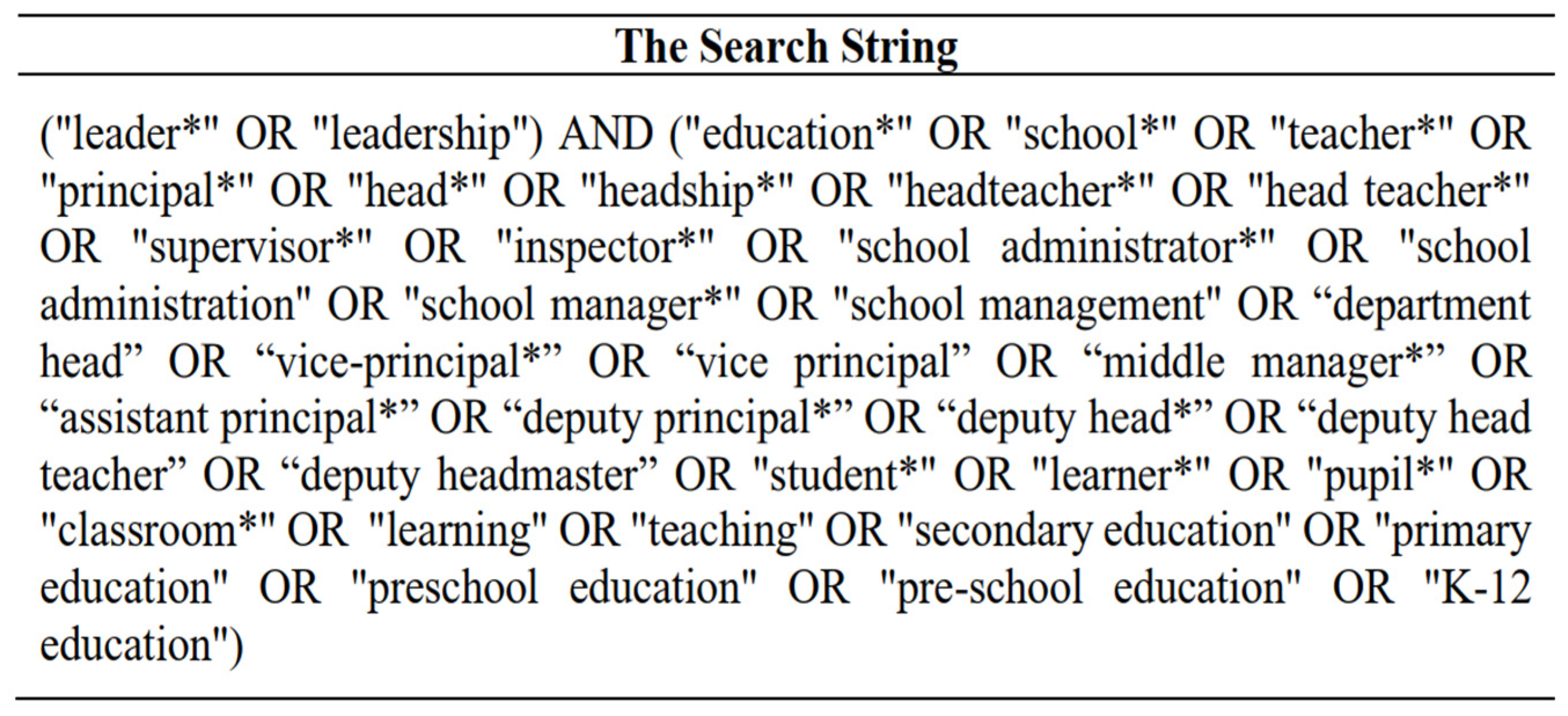
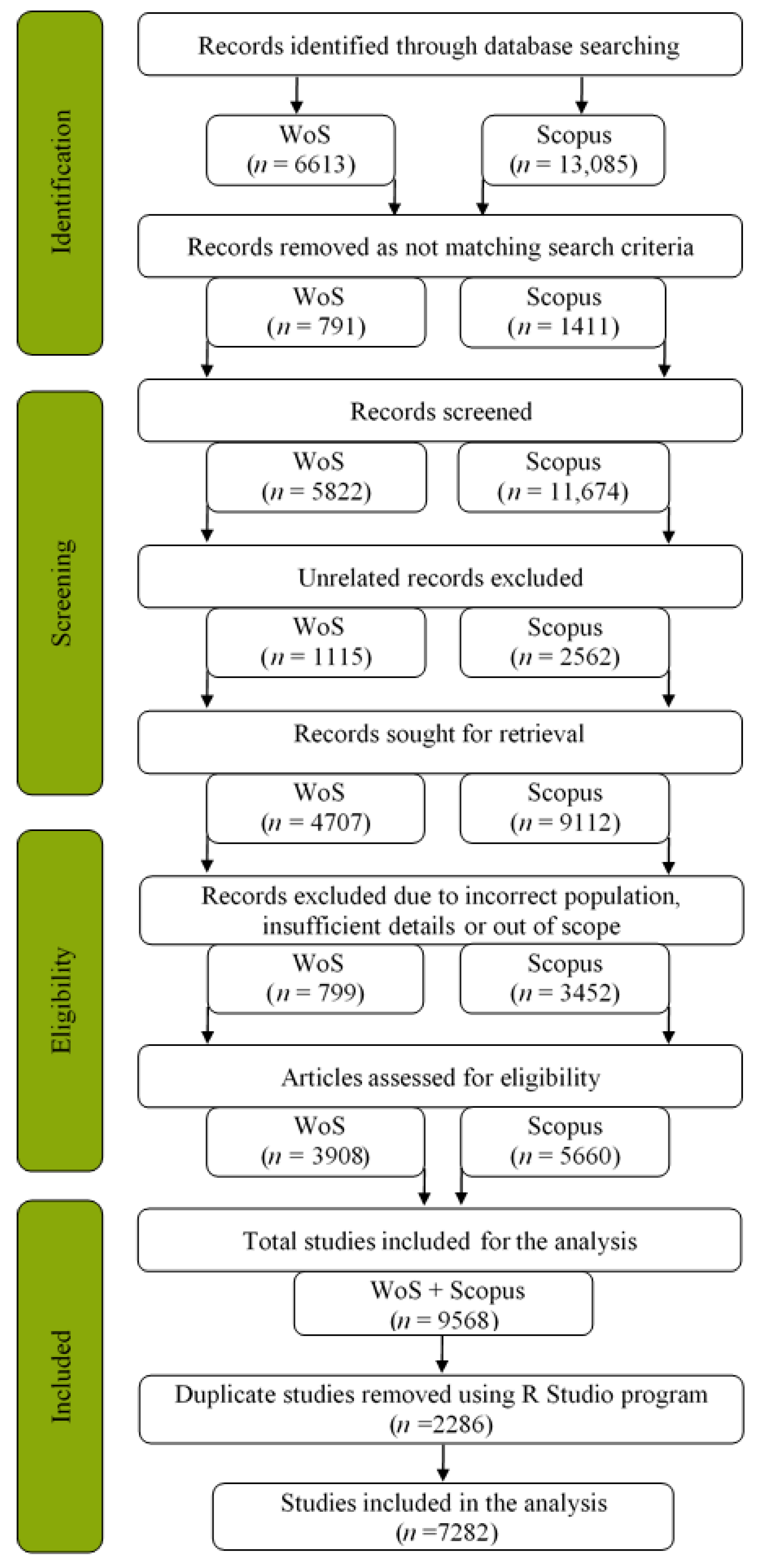
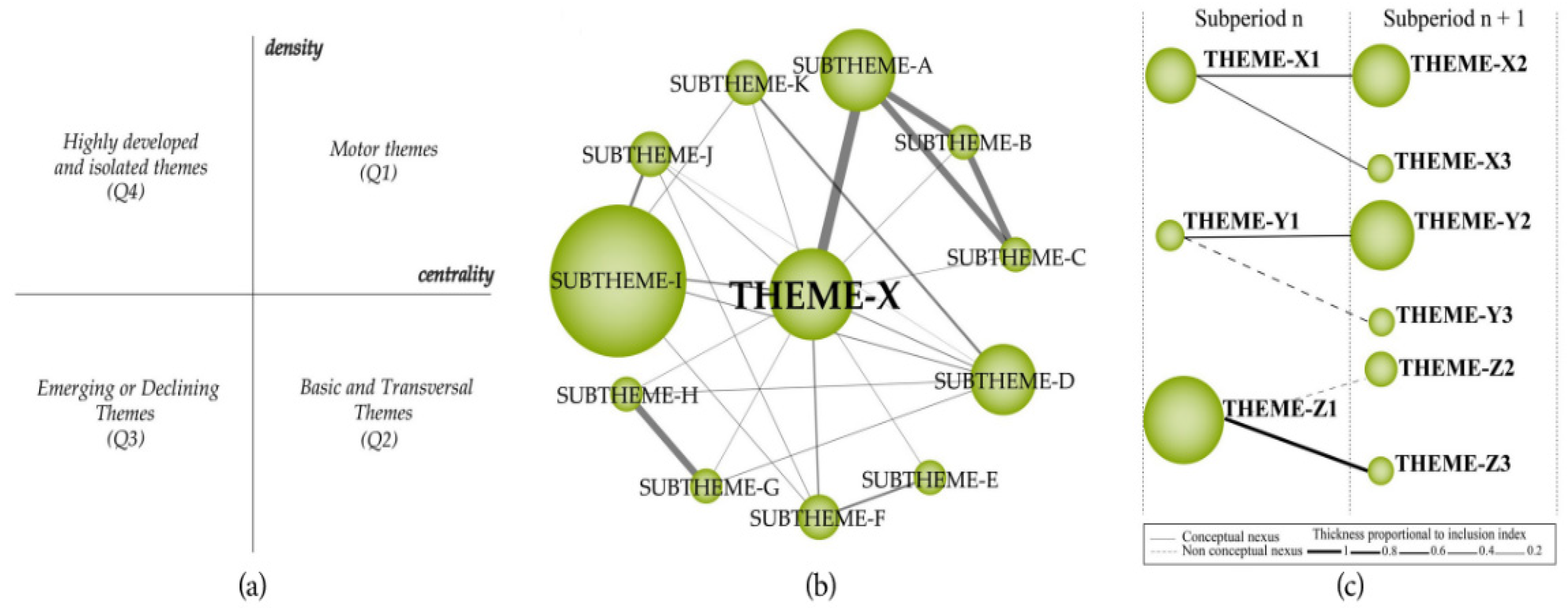
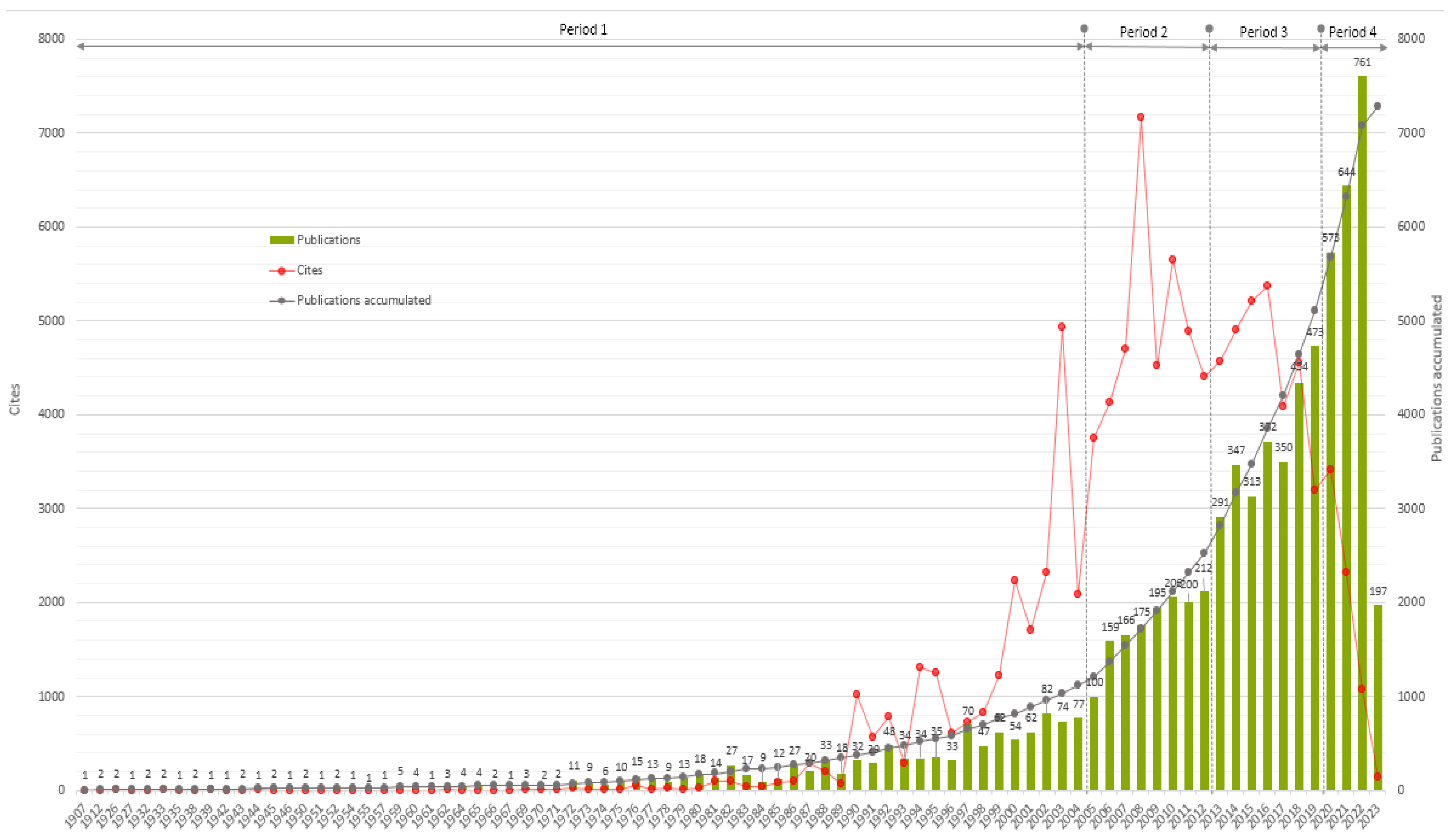
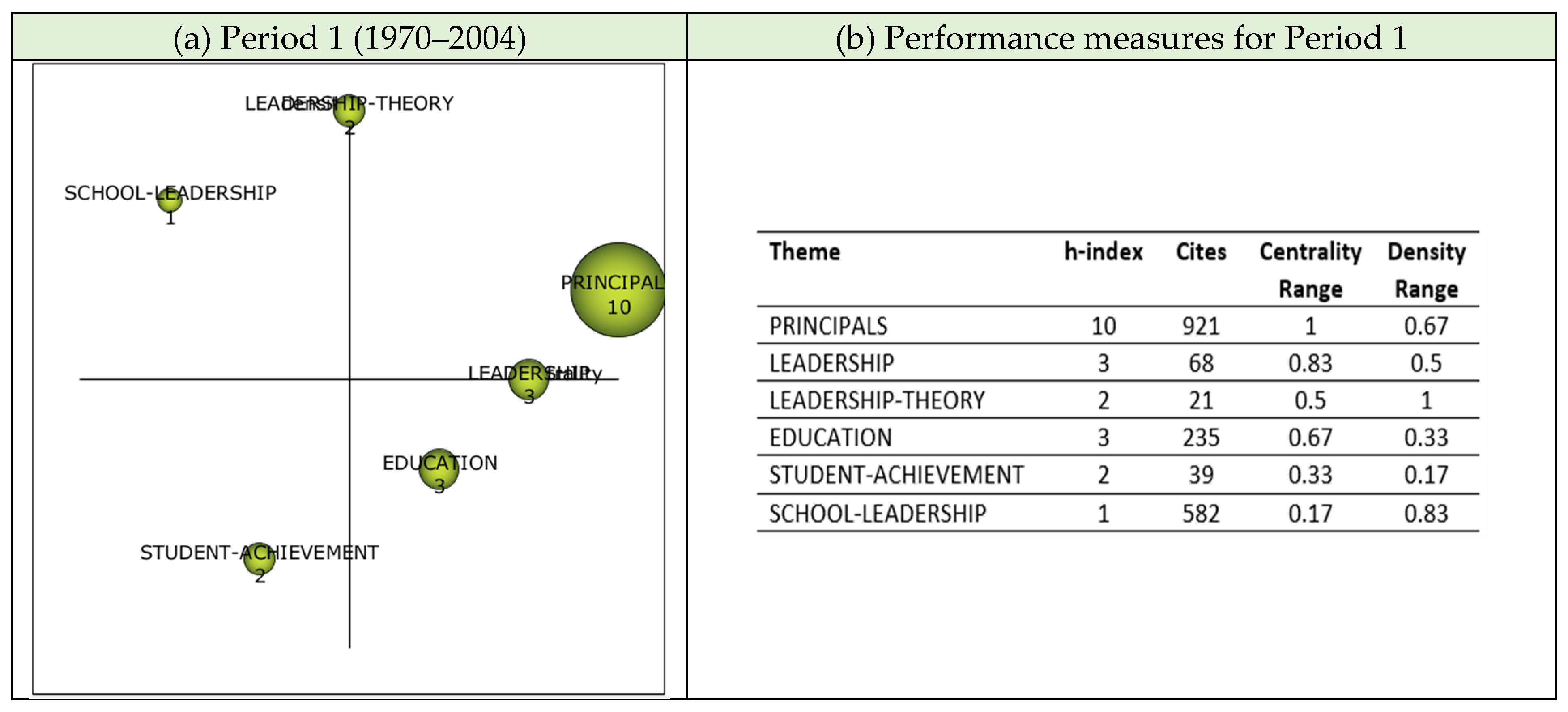


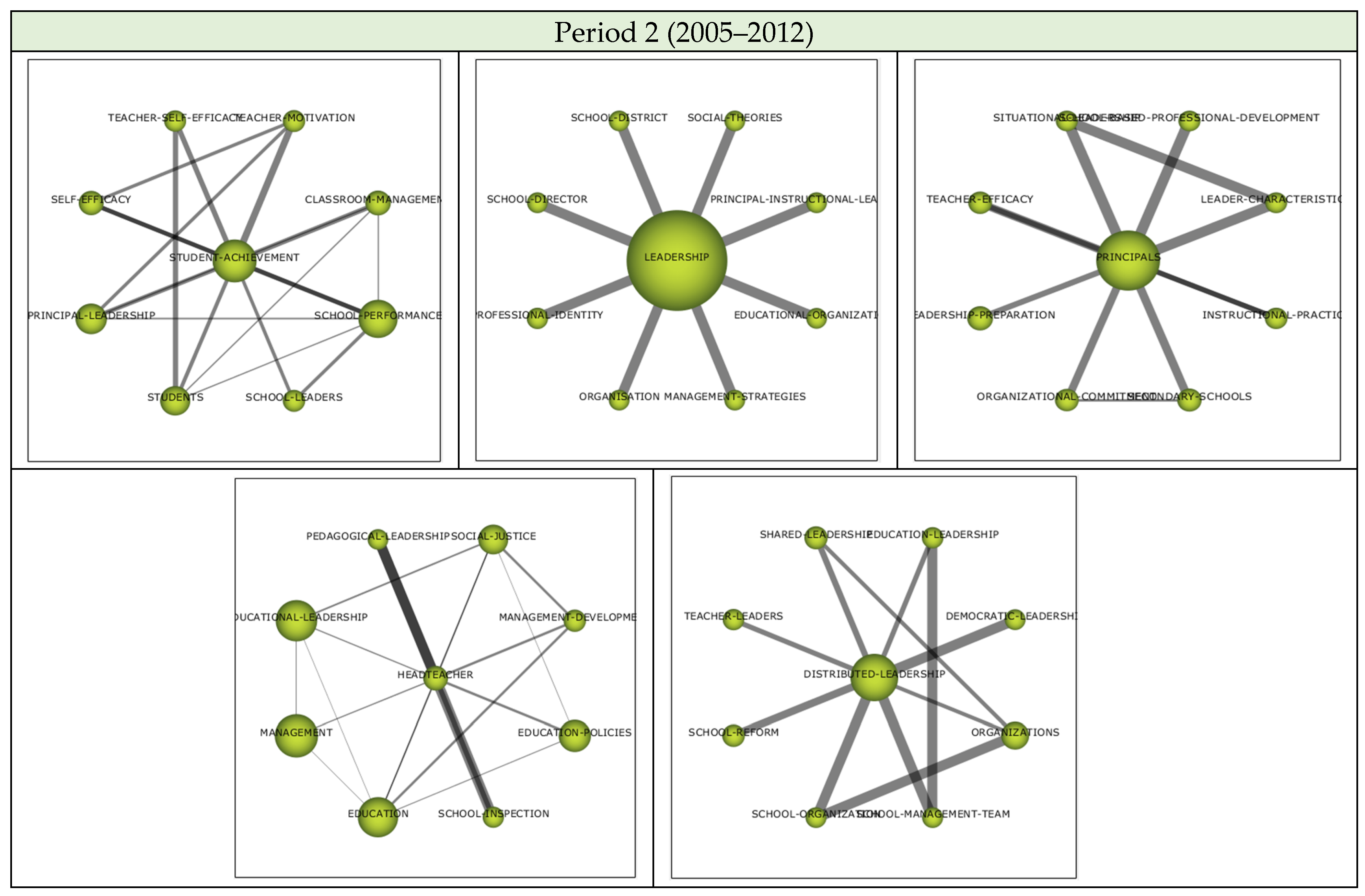
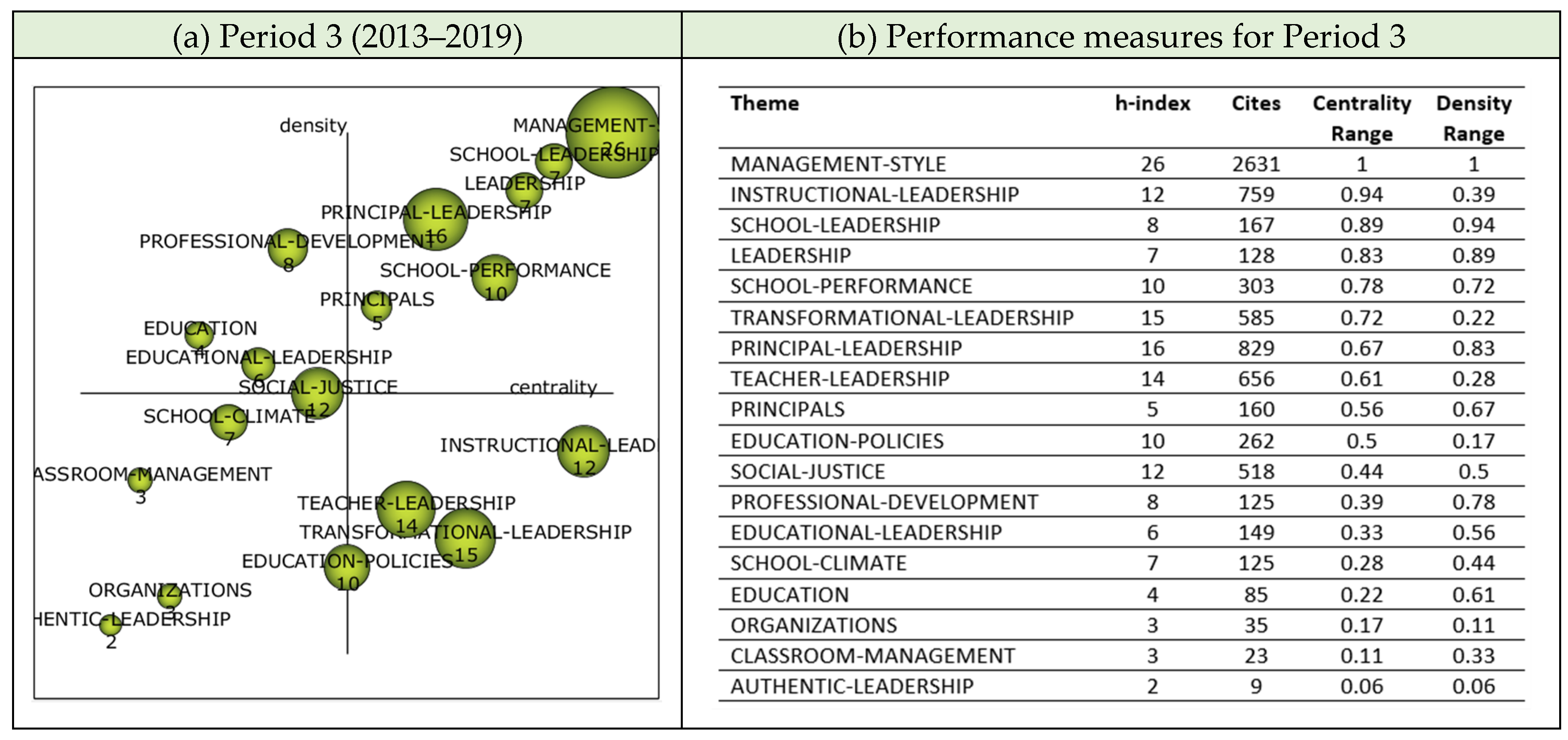

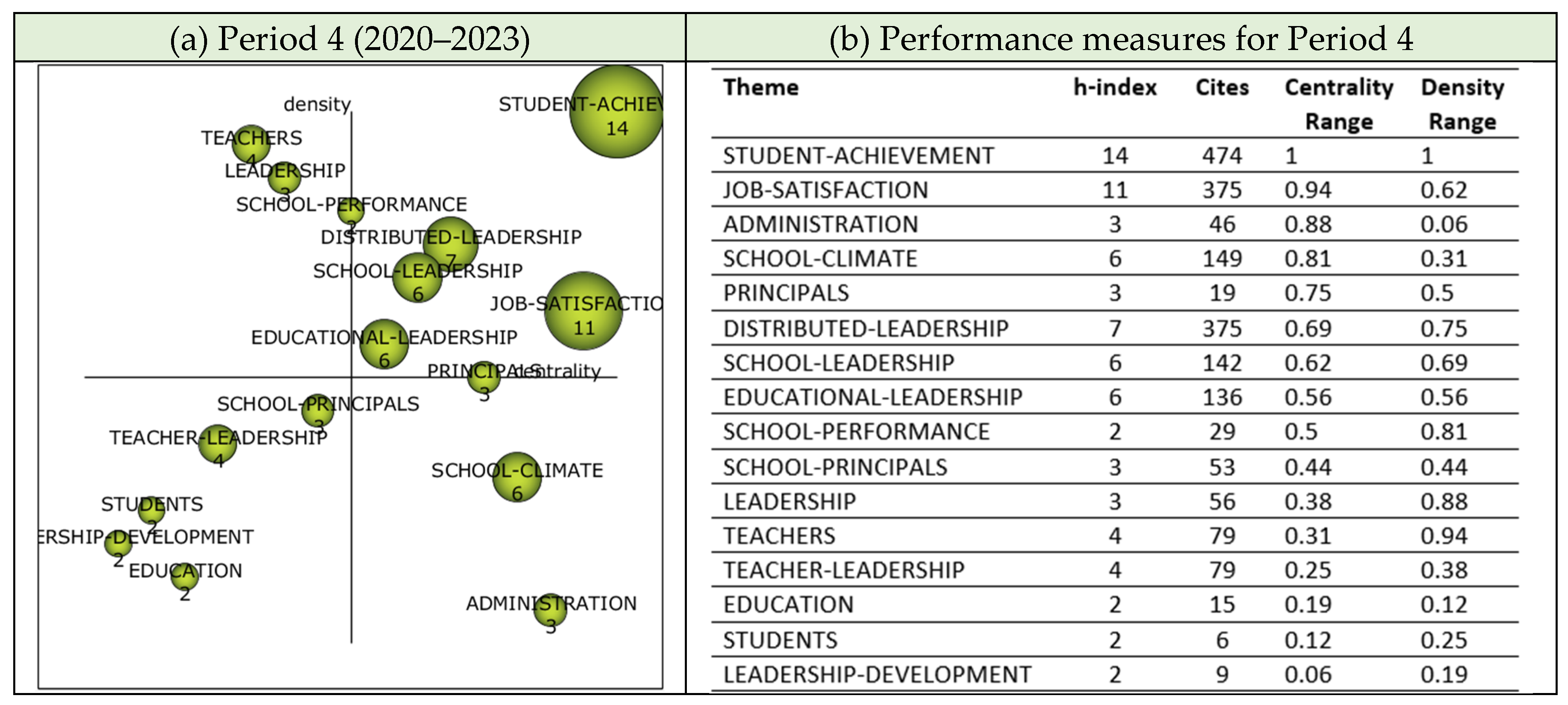
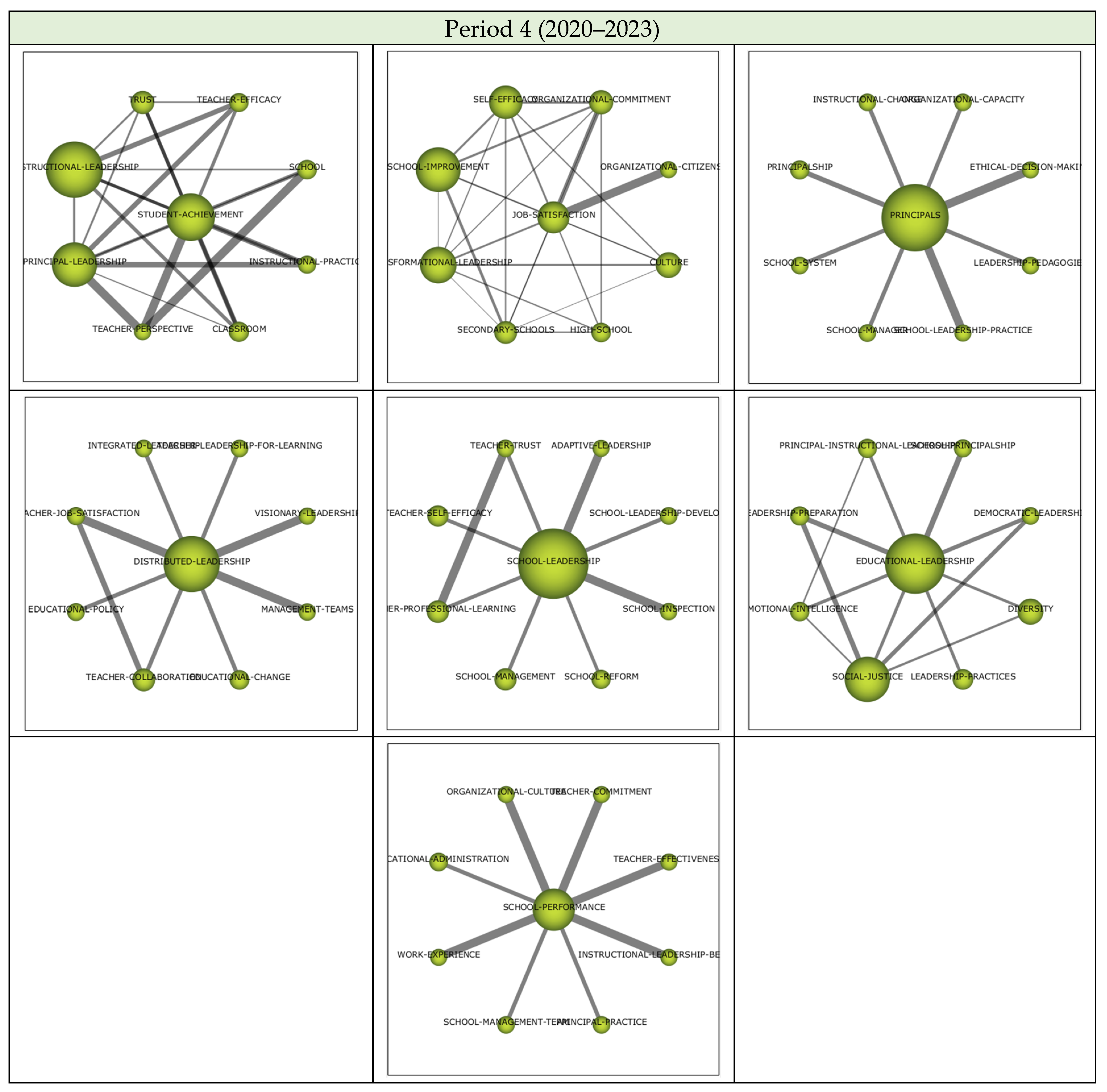
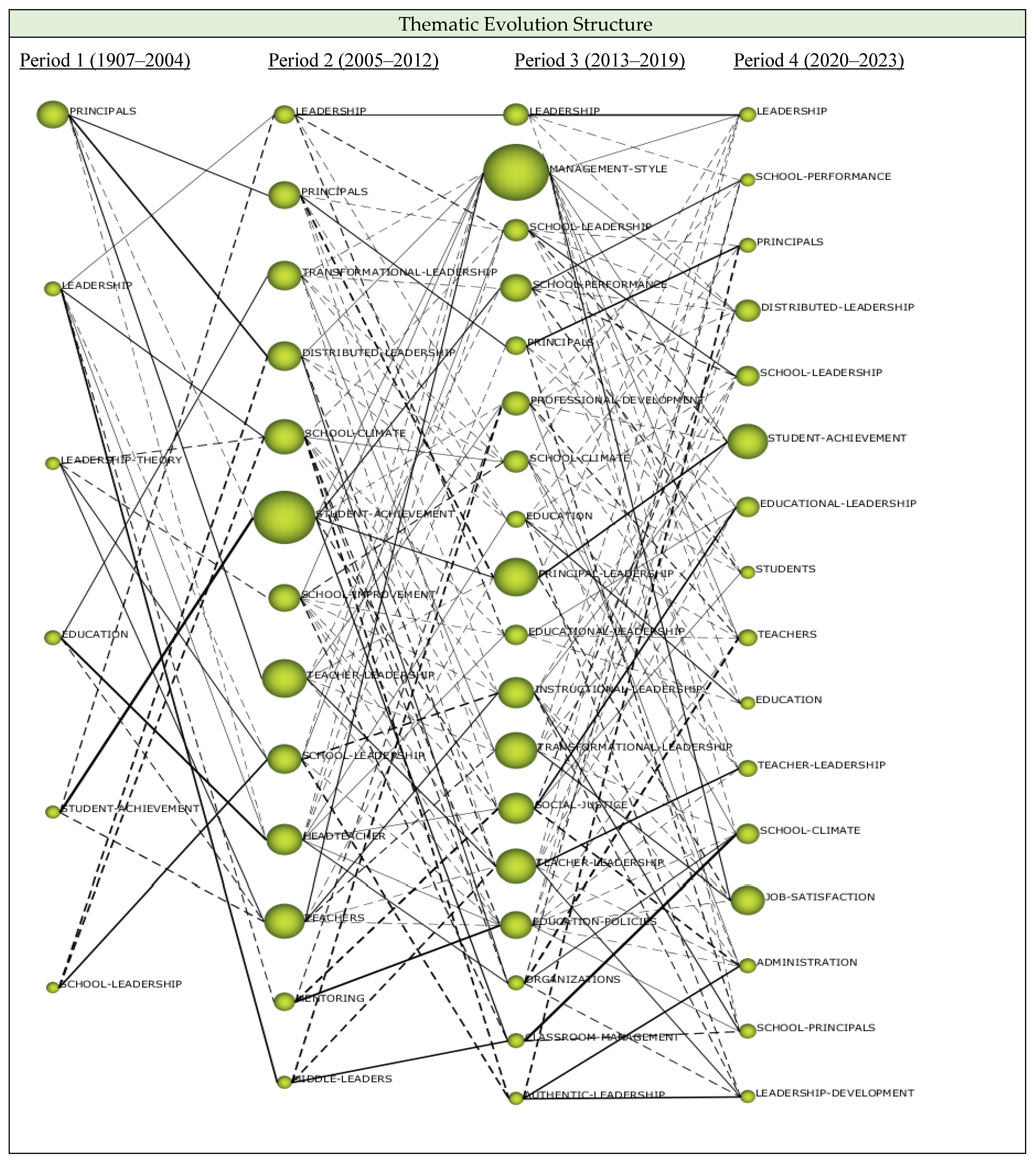
| Rank | Journal Name | TC * | TP ** |
|---|---|---|---|
| 1 | Educational Administration Quarterly | 16,064 | 257 |
| 2 | Journal of Educational Administration | 8888 | 329 |
| 3 | Educational Management Administration and Leadership | 7941 | 446 |
| 4 | School Leadership and Management | 6580 | 264 |
| 5 | International Journal of Leadership in Education | 4336 | 387 |
| 6 | School Effectiveness and School Improvement | 3459 | 65 |
| 7 | Leadership and Policy in Schools | 2615 | 192 |
| 8 | International Journal of Educational Management | 1825 | 149 |
| 9 | Teaching and Teacher Education | 1516 | 41 |
| 10 | Journal of Research on Leadership Education | 1206 | 154 |
| Rank | Author | TP * | TC | Rank | Author | TC ** | TP |
|---|---|---|---|---|---|---|---|
| 1 | Hallinger, Philip | 90 | 6232 | 1 | Hallinger, Philip | 6232 | 90 |
| 2 | Leithwood, Kenneth | 41 | 5736 | 2 | Leithwood, Kenneth | 5736 | 41 |
| 3 | Walker, Allan | 28 | 1002 | 3 | Harris, Alma | 2747 | 27 |
| 4 | Berkovich, Izhak | 28 | 392 | 4 | Jantzi, Doris | 2250 | 27 |
| 5 | Harris, Alma | 27 | 2747 | 5 | Heck, Ronald H. | 2110 | 23 |
| 6 | Schechter, Chen | 26 | 367 | 6 | Spillane, James P. | 1375 | 24 |
| 7 | Devos, Geert | 25 | 813 | 7 | Robinson, Viviane M. J. | 1146 | 8 |
| 8 | Spillane, James P. | 24 | 1375 | 8 | Louis, Karen Seashore | 1290 | 15 |
| 9 | Heck, Ronald H. | 23 | 2110 | 9 | Lloyd, Claire A. | 1122 | 2 |
| 10 | Murphy, Joseph | 22 | 795 | 10 | Rowe, Kenneth J. | 1122 | 2 |
| Rank | Article Title | Journal Name | Author(s)/Year | TC * | |
|---|---|---|---|---|---|
| Scopus WoS | |||||
| 1 | The impact of leadership on student outcomes: An analysis of the differential effects of leadership types | Educational Administration Quarterly | Robinson V.M.J., Lloyd C.A., Rowe K.J., 2008 | 1109 | 973 |
| 2 | Seven strong claims about successful school leadership | School Leadership& Management | Leithwood, K., Harris, A.; Hopkins, D., 2008 | 736 | 651 |
| 3 | Leading educational change: Reflections on the practice of instructional and transformational leadership | Cambridge Journal of Education | Hallinger P., 2003 | 679 | n/a |
| 4 | Principal leadership and school performance: An integration of transformational and instructional leadership | Educational Administration Quarterly | Marks, H.M., Printy, S.M., 2003 | 657 | 584 |
| 5 | Social justice educational leaders and resistance: Toward a theory of social justice leadership | Educational Administration Quarterly | Theoharis G., 2007 | 496 | 447 |
| 6 | Leadership for learning: Lessons from 40 years of empirical research | Journal of Educational Administration | Hallinger P., 2011 | 397 | 332 |
| 7 | Leadership for school restructuring | Educational Administration Quarterly | Leithwood K., 1994 | 387 | 284 |
| 8 | Educational leadership and student achievement: The elusive search for an association | Educational Administration Quarterly | Witziers B., Bosker R.J., Krüger M.L., 2003 | 361 | 315 |
| 9 | Shaping teacher sensemaking: School leaders and the enactment of reading policy | EducationalPolicy | Coburn C.E., 2005 | 359 | 294 |
| 10 | The effects of transformational leadership on organizational conditions and student engagement with school | Journal of Educational Administration | Leithwood K., Jantzi D., 2000 | 346 | n/a |
| Rank | Country | TP * | TC |
|---|---|---|---|
| 1 | USA | 2495 | 40,167 |
| 2 | United Kingdom | 708 | 11,804 |
| 3 | Australia | 491 | 6939 |
| 4 | Canada | 315 | 7784 |
| 5 | Türkiye | 287 | 2304 |
| 6 | South Africa | 260 | 2065 |
| 7 | Spain | 239 | 1518 |
| 8 | Israel | 186 | 2119 |
| 9 | Malaysia | 173 | 1155 |
| 10 | China | 161 | 3021 |
Disclaimer/Publisher’s Note: The statements, opinions and data contained in all publications are solely those of the individual author(s) and contributor(s) and not of MDPI and/or the editor(s). MDPI and/or the editor(s) disclaim responsibility for any injury to people or property resulting from any ideas, methods, instructions or products referred to in the content. |
© 2024 by the authors. Licensee MDPI, Basel, Switzerland. This article is an open access article distributed under the terms and conditions of the Creative Commons Attribution (CC BY) license (https://creativecommons.org/licenses/by/4.0/).
Share and Cite
Karakose, T.; Leithwood, K.; Tülübaş, T. The Intellectual Evolution of Educational Leadership Research: A Combined Bibliometric and Thematic Analysis Using SciMAT. Educ. Sci. 2024, 14, 429. https://doi.org/10.3390/educsci14040429
Karakose T, Leithwood K, Tülübaş T. The Intellectual Evolution of Educational Leadership Research: A Combined Bibliometric and Thematic Analysis Using SciMAT. Education Sciences. 2024; 14(4):429. https://doi.org/10.3390/educsci14040429
Chicago/Turabian StyleKarakose, Turgut, Kenneth Leithwood, and Tijen Tülübaş. 2024. "The Intellectual Evolution of Educational Leadership Research: A Combined Bibliometric and Thematic Analysis Using SciMAT" Education Sciences 14, no. 4: 429. https://doi.org/10.3390/educsci14040429
APA StyleKarakose, T., Leithwood, K., & Tülübaş, T. (2024). The Intellectual Evolution of Educational Leadership Research: A Combined Bibliometric and Thematic Analysis Using SciMAT. Education Sciences, 14(4), 429. https://doi.org/10.3390/educsci14040429








